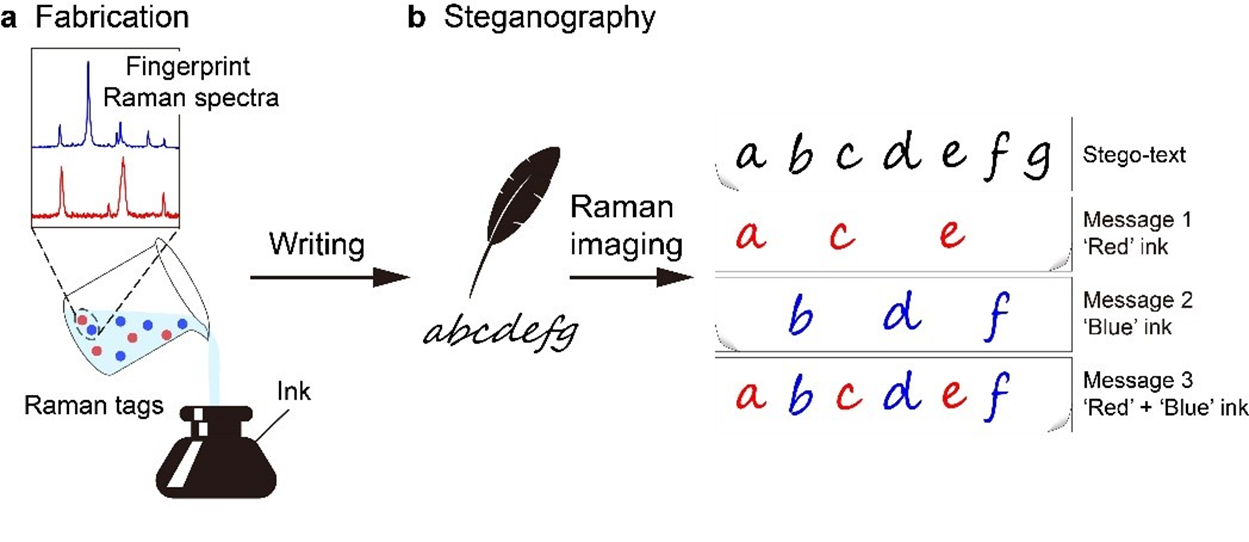


Team led by professor Jian Ye from the School of Biomedical Engineering successfully implemented multi-color steganography based on Raman ink
January 19, 2021
Techniques for security information protection are of great significance in the highly developed information society. A massive volume of political, military, commercial, and personal information is generated and transmitted every day, but it is susceptible to loss, interception, and manipulation.Therefore, it is rather important to establish a powerful and robust security system to combat against information leakage. Encryption is a commonly used approach for data security, which encrypts messages into directly unreadable data. One of the main disadvantages of data encryption is that it focuses on the concealment of data content rather than the existence of the data itself, which may cause the invader's suspicion and probably lead to data destruction or eventual decryption. One of the methods to solve this issue is steganography, also known as “invisible” communication. It refers to the technique of hiding information into another medium (e.g., video, audio, image, and text). The media with and without hidden information are called stego media and cover media, respectively. In contrast to data encryption, steganography aims to hide the existence of information so that it will not attract the third party's attention during transmission process and can achieve the purpose of secure transmission.
Steganography includes a number of secret communication approaches, such as security ink, microdots, character arrangement, digital signatures, covert channels, and spread spectrum communications. Among them, security ink is widespread with a long history. Invisible ink, as one of the most important forms of security ink, is colorless and unidentifiable to the naked eye under normal conditions, but turns visible after treatment with heat, water, light, or specific chemicals. However, such way to convey information using completely invisible forms (such as a blank sheet of paper) may arouse suspicion over a supervised channel. Surface‐enhanced Raman scattering (SERS) nanotags are well suited to information encoding owing to their nanoscale dimensions, fingerprint optical spectral features, and remarkable multiplexing capability.

Recently, team led by Jian Ye publish their research work entitled “Raman ink for steganography” in the journal Advanced Optical Materials. In this study, Raman ink, fabricated by doping a new type of SERS nanotags (gap‐enhanced Raman tags, GERTs) into commercial ink, is demonstrated as security ink for multiplexing steganography. A stego‐text is written using two types of Raman ink containing different GERTs with diverse Raman signals, imaged via a confocal Raman system, and processed by the classical least squares method to extract the hidden message. The Raman ink generates distinct spectral profiles with low background from pure ink upon near‐infrared laser irradiation. A multiplexing combination of seven kinds of messages extracted from the written stego‐text is demonstrated, which adds enhanced safety and flexibility to information encoding. In addition, Raman ink exhibits good photostability and long‐term stability. Therefore, GERTs‐based Raman ink is promising for steganographic use in information security.

This study was completed by Jian's Ye research group in the School of Biomedical Engineering, Shanghai Jiao Tong University. Doctoral student Yuqing Gu was the first author, and Professor Jian Ye was the corresponding author. This study was supported by the National Natural Science Foundation of China (no. 81871401), the Science and Technology Commission of Shanghai Municipality (no. 19441905300), Innovation Research Plan supported by Shanghai Municipal Education Commission (no. ZXWF082101), Shanghai Jiao Tong University (nos. YG2017MS54 and YG2019QNA28), and Shanghai Key Laboratory of Gynecologic Oncology.
Link: https://onlinelibrary.wiley.com/doi/full/10.1002/adom.202002038